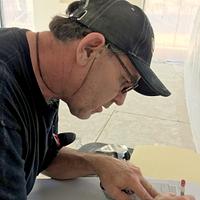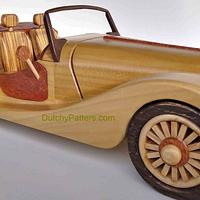Share your craft projects
Make new craft buddies
Ask craft questions
Blog your craft journey

shipwright
2135 posts
and
113 followers
in over 11 years
in over 11 years
Shipyard Memories #4: Planking
This is
part 4
in a
22 part
series:
Shipyard Memories
Probably the most anticipated part of building a wooden boat is the planking. The old boat builder I learned from used to call it "boardin' 'er up". It represents the transformation from a building project to something an owner can start thinking of as "My Boat". There are many tricks and nuances to planking that I will not try to explain here; suffice to say that it's not as easy as it looks - until you've done it a few times anyway. If done well the boat looks "right"and it won't really be noticed, but if done poorly it really shows and will most definitely be noticed. On this job it was made a bit more critical because the owner wanted to finish bright, no paint. The planking here is 1 1/2" yellow cedar, fastened with silicon bronze screws.
The first photo shows a batten that has been tacked to the ribs about mid girth. This batten represents the most important line in the planking scheme. It is the dividing line between the topside planking and the bottom planking and getting it in the right place before you start to cut any boards is crucial. All planks above this line will be the same width at any station on the hull. This not only gives a handsome appearance but makes it much easier to mark out, cut and fit the planks. Below this line there is a great deal more area to be covered aft than forward so it is not possible to have the repeatable pattern used in the topsides. It's an acquired "eye" that lets you fiddle this batten into the "just right" position.
The first photo shows a batten that has been tacked to the ribs about mid girth. This batten represents the most important line in the planking scheme. It is the dividing line between the topside planking and the bottom planking and getting it in the right place before you start to cut any boards is crucial. All planks above this line will be the same width at any station on the hull. This not only gives a handsome appearance but makes it much easier to mark out, cut and fit the planks. Below this line there is a great deal more area to be covered aft than forward so it is not possible to have the repeatable pattern used in the topsides. It's an acquired "eye" that lets you fiddle this batten into the "just right" position.

Once the dividing line is defined, a pattern is drawn up for the topside planking and the bottom is planned out "a row at a time". Here the topside planking has been started and the keelson is being prepared for the garboard, the first plank above the keel.

In this one three rows of planks have been fastened on the bottom and the fourth is clamped in position. This is a good shot of the bronze straps from the inside and the 3" sided yellow cedar floor timbers.

I put this photo in to show the extent of the stationary tools I had at the time, a 36" Crescent band saw, a 6"x 20" Park planer and a General 10" cabinet saw (souped up with a 5 horse three phase motor). I think there was a small drill press around somewhere too.

Here the planking is progressing nicely, probably about four or five days in. If you look carefully at the picture above and the two below, you can see how much space had to be "caught up" aft on the bottom. This is often done as was here by using "stealers", where one forward plank buts against two aft allowing one strake of planking to go from say 6" at the stem to maybe 14" at the stern post.

The planking is finished here. Two things to note. The topside planking is usually narrower than bottom planking because 1) It is more likely to dry out and the resulting shrinkage will be less trouble spread out over more seams, 2) It looks better and 3) The bottom has the large area differential forward to aft discussed above. Second interesting thing here is that one plank is quite a bit darker than the others. It got left in the steam box too long and became discolored on the surface. It wasn't in long enough to damage it and the color sanded off easily. It is worth saying that all planks are steamed, even if they are easy bends. As steaming drys the wood out, this insures that all planks are dried equally.

As I said last time, I just love the stern view of this boat, It makes me think of a big mandolin. This is freshly planked and rough. It will now be faired and sanded and it will look much sweeter.

I apologize for not having more detail photos or more shots of work being done but back then I didn't know I'd be doing this now. I have to work with the photos I have.
Thanks for checking in. As always questions and critiques are encouraged.
Next up is decking and lead keel.
'til next time
Paul
The early bird gets the worm but its the second mouse that gets the cheese.
10 Comments
As always questions and critiques are encouraged
Was just going to say, the fifth plank on the left looks a little skinny at the end, I hope you took care of that. haha
Fascinating, when I get a chance I'm going to start at the 1st and go through them and see what other smart ass comments I can make. :)
Fascinating, when I get a chance I'm going to start at the 1st and go through them and see what other smart ass comments I can make. :)
Figuring out how to do something you have never done is what makes a good challenge.
So nice to follow this Paul.
This chit never gets old...just awesome.
The man in the suit has just bought a new car from the profit he's made on your dreams.
So, if you were to build a model, say a couple feet of waterline, would it be interesting at all to use the same techniques in the small, or would it be too much of a pain in the butt to be worth it?
May you have the day you deserve!
I once attempted to do exactly that (a little smaller actually) and discovered that there is a reason model builders have their own methods and tricks. 😅
The concepts are the same but the process doesn’t exactly scale well.
The concepts are the same but the process doesn’t exactly scale well.
The early bird gets the worm but its the second mouse that gets the cheese.
That’s about what I figured. And you seemed like the kind of guy who would’ve tried it. Good to know. Thanks!
May you have the day you deserve!
I can see where you have to plan about 3-4 steps ahead during a build. I have thought about scale models, just to get the feel of the process, still may need to give it a try.
In today's world, this is a lost trade with all of the plastics and fiberglass, I know there are folks out there that have or are building their own form plans. If I grew up on the coast, I would have pursued a career in a boatyard.
Thanks for the journey, Paul.
In today's world, this is a lost trade with all of the plastics and fiberglass, I know there are folks out there that have or are building their own form plans. If I grew up on the coast, I would have pursued a career in a boatyard.
Thanks for the journey, Paul.
Main Street to the Mountains
I can see where you have to plan about 3-4 steps ahead during a build
I used to build the whole thing in my head over and over as I built. So yes, you are absolutely right but more than 3-4 steps.
The early bird gets the worm but its the second mouse that gets the cheese.
I used to build the whole thing in my head over and over as I built.
Yeah, Sketchup would not be much help out on deck...
Question on the planking. As each plank is tapered at the ends, do you taper both edges, or just one?
And also how do you determine how much to taper each piece from the get go?
I'm going to guess (just to see how far off I am) After you mount the first few bottom pieces and the top piece or two, you measure the distance to cover and divide it by the number of pieces you are going to use?
Question on the planking. As each plank is tapered at the ends, do you taper both edges, or just one?
And also how do you determine how much to taper each piece from the get go?
I'm going to guess (just to see how far off I am) After you mount the first few bottom pieces and the top piece or two, you measure the distance to cover and divide it by the number of pieces you are going to use?
Figuring out how to do something you have never done is what makes a good challenge.
In the first pic, the line of that batten divides the topside planking from the bottom planking. All topside planks come from a pattern drawn up pretty much as you described.
The bottom is not as symmetrical. It is much bigger in the stern than in the bow so all the planks there are individually laid out in rows.
The narrow topside planks are “edge set” into place, meaning bent on edge to fit the curve. The wider ones on the bottom are “spiled” or shaped to form around the compound curve.
The may look straight on the boat but in fact be quite a banana shape when laid flat.
The bevel for caulking (5 degrees) is planed on the bottom of each plank and almost all are left square on top.
The bottom is not as symmetrical. It is much bigger in the stern than in the bow so all the planks there are individually laid out in rows.
The narrow topside planks are “edge set” into place, meaning bent on edge to fit the curve. The wider ones on the bottom are “spiled” or shaped to form around the compound curve.
The may look straight on the boat but in fact be quite a banana shape when laid flat.
The bevel for caulking (5 degrees) is planed on the bottom of each plank and almost all are left square on top.
The early bird gets the worm but its the second mouse that gets the cheese.













